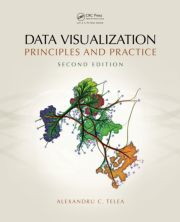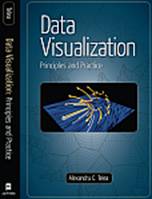Books
The course has a mandatory book. This one of the two editions of the book below:

Data Visualization - Principles and Practice (2nd edition)
- author: A. C. Telea
- publisher: CRC Press
- publication date: 2014
- index information: ISBN 9781466585263
Advantages of the second edition:
- correctness: Several small-scale errors (in formulas and figure annotations) have been corrected. This is important for the theory exam.
- completeness: About 40% more material than the 1st edition. This material is very important if you are planning to take next your MSc project in a data-visualization-related field.
- online material: The data structures and algorithms are described in a more complete way. Also, source-code implementation is provided for these new descriptions, making it easy to connect the theory in the book with practice (building your own application).
- e-book: The second edition is also available in e-book format.

Data Visualization - Principles and Practice (1st edition)
- author: A. C. Telea
- publisher: A. K. Peters Ltd.
- publication date: 2007
- index information: ISBN-10: 1568813066, ISBN-13: 978-1568813066
You can find more information on these books online at the publisher's site. The books are available also via Amazon or similar online stores.
Mandatory chapters
Below is a mapping of the book chapters to topics covered in this lecture:
Chapter 1: Introduction
Introductory chapter, in line with the course's introduction slides.
Chapter 2: From Graphics to Visualization
Not explicitly covered in the course slides. This chapter is however important as a quick OpenGL primer for executing the practical assignment.
Chapter 3: Data Representation
In line with the data representation course module.
Chapter 4: The Visualization Pipeline
In line with the first introductory lecture.
Chapter 5: Scalar Visualization
In line with the scalar algorithms course module.
Chapter 6: Vector Visualization
In line with the vector algorithms course module.
Chapter 7: Tensor Visualization
In line with the tensor algorithms course module.
Chapter 10: Volume Visualization
In line with the volume algorithms course module.
The above chapters provide both practical information for completing the assignment, and also the theory which will be tested at the exam. The other chapters are not, strictly speaking, necessary to be read to take this course.
